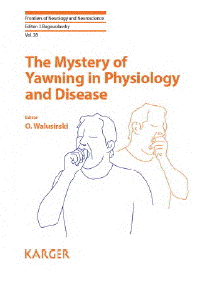My most disquieting experiences on the
lecture podium were addressing (a) a woman
snoring loudly in the front row of Liverpool's
Royal Institution, and (b) a young man
yawning more or less continuously for 45
minutes at the University of Bristol.
He was by far the worse of the two, but why
was he yawning? The more one wonders about being
yawned at, the less clear the answer becomes.
When a person yawns, just as we are trying to
say something significant, is it a
neurophysiological consequence or their boredom?
Or are they consciously telling us that they are
bored? Certainly boredom and drowsiness are each
associated with yawning. Yet there is no decent
evidence that these things are causally
related.
So the issue broadens: what is yawning for
anyway? Again, the little information in even
the most advanced textbooks permits no
definitive verdict. There is usually a
suggestion that yawning has an inspiratory
function, and that it is triggered by anoxia.
Yet experimental data, published over the past
10 years, have shown that a rise in carbon
dioxide has nothing to do with yawning. Try
holding your breath for as long as possible, and
see whether you yawn. No, the anoxia theory must
be nonsense.
Other explanations? There are at least ten.
Yawning prevents the loss of lung compliance
during normal breathing. Yawning provides a
pulse of thyroid hormones by squeezing the
thyroid gland. Yawning synchronises sleep among
group-living animals. Yawning is an integrated
discharge in a bulboreticular motor structure
occurring at a particular level of activity of
the reticular formation corresponding to a
decrease in wakefulness preceding sleep. Yawning
has no physiological function at all. And so
on.
None of these proposals is anything like
proved. And that is rather weird, for a reflex
action that is universal, that (like a sneeze)
cannot be fully suppressed once it is initiated,
and that is so powerful it can dislocate your
jaw. Our ignorance is even odder when you
consider that yawning is contagious among groups
of people, and can even be encouraged by
autosuggestion when we think or read about it.
Assuming you have read this far, have you yawned
yet?
Now try this for a bold hypothesis, advanced
by Andrew McKenzie of the University of Pretoria
in the South African Journal of Science
(1994;90:64). "The yawn," writes mammal
researcher McKenzie, "is a complex, centrally
mediated, muscular contraction which ensures
intermittent evacuation of the palatine
tonsillar fossae, ensuring that the tonsils are
exposed to new antigens and preventing excessive
accumulation of foreign material, microorganisms
and inflammatory products." Yawning, in other
words, is the answer to the puzzle of why our
tonsils, which seem to offer an excellent
environment for chronic infection - thanks to
the regular provision of masticated food and its
associated bacteria - do not usually become
infected. Although evacuating reflexes exist to
clear other sites such as the nose (sneezing),
lungs (coughing), eyes (blinking) and mouth
(swallowing), no such mechanism has been
identified for the tonsillar fossae. Could
yawning serve this purpose?
One argument advanced by McKenzie in support
of his novel notion is that the yoga exercise of
Simhasana - stretching the pharyngeal muscles to
the extreme by raising your head and sticking
our your tongue - seems to be effective for
preventing and treating tonsillitis. It's
agreeable too that the new theory accords with a
wide variety of evidence, including the
prodigious yawning of the carnivores, whose food
contains an abundance of microorganisms and
provides an ideal, protein rich culture medium
for bacterial multiplication.
If Andrew McKenzie is right we'll have to
revise our view that it is rude to yawn in
public. Could this taboo, strongly instilled in
children in the past, have been responsible for
the high incidence of tonsillitis and
tonsillectomy in times gone by? I'm not sure if
I follow McKenzie's speculations that far. But I
do like his central hypothesis.


